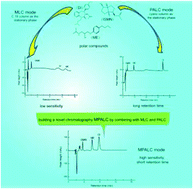Micellar per aqueous liquid chromatography: an alternative to micellar liquid chromatography for determination of polar compounds?
Abstract
In order to improve the sensitivity of micellar liquid chromatography, we have developed a new liquid chromatographic method named micellar per aqueous liquid chromatography and studied its chromatographic behavior for the separation of diltiazem hydrochloride, metoprolol tartrate and isosorbide mononitrate. The results showed that the chromatographic performance of micellar per aqueous liquid chromatography is much better than that of micellar liquid chromatography because the former has a shorter analysis time, higher sensitivity and better resolution than the latter in the assay of the analytes under optimized chromatographic conditions. We have determined the factors influencing retention behavior, such as the concentration of sodium dodecyl sulfate, organic solvents and pH to clarify the possible separation mechanisms of both chromatographic methods. Modifications on the surface of the stationary phases caused by additives in the mobile phases are the major differences between these two chromatographic methods, which makes micellar per aqueous liquid chromatography much better able to nullify the deteriorated peak shape and low sensitivity caused by excessive surfactant adsorbed on the surface of the stationary phase. The new chromatographic method might be a good alternative to traditional micellar liquid chromatography for the separation of polar compounds.


 Please wait while we load your content...
Please wait while we load your content...